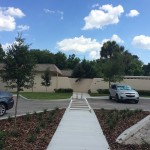Renovations inspire Greek revival on campus
The three-story Federal Colonial mansion at the corner of Southwest 13th Street and Second Avenue has been affectionately known to the alumni and current members of the Alpha Tau Omega fraternity as the Tau Mansion for seven decades.
Tau Mansion, with its striking facade, distinctive dormers and colonnade-framed entrance, has been home to thousands of fraternity brothers during the 73 years it has stood across from the entrance to the University of Florida.
“We who have been members of this fraternity have always been fond of that structure,” said John Marion, president of the chapter house corporation and chairman of the board of trustees.
But the house was aging. It had sprung leaks. It had chronic problems that led alumni to long discussions about whether to renovate their beloved house or tear it down and rebuild. They ultimately decided to renovate because of their fondness for the quirky old mansion.
“It couldn’t be duplicated under current building codes,” said Marion, who was chapter president in 1978 during his second to last year at UF. He graduated in 1979.
The Tau Mansion is one of two major renovations of Greek houses this summer. Kappa Kappa Gamma, a sorority house two blocks down the road, completed a new residential wing in time for fall recruitment.
Those renovations are part of an unusually high amount of construction activity along a highly visible and bustling section of Southwest 13th Street. Other projects include the construction of Heavener Hall and Cypress Hall on the UF campus, and the construction at Trimark Properties that has closed off Southwest Third Avenue for most of the summer.
At least 18 of the 39 houses are undergoing modifications and improvements of one type or another — most of them minor upgrades, new paint jobs and roofs, up to kitchen remodels.
“We’re excited as a university to see the investment of various fraternities and sororities, because it means the students are interested in these houses,” said Jeanna Mastrodicasa, assistant vice president for student affairs.
Greek life is on the upswing at UF, despite some negative publicity in recent years about hazing and other conduct violations that led to disciplinary actions against several houses.
In the past six years, the Greek population has grown from 14 percent to 20 percent of the undergraduate population, said Jack Causseaux, associate director of Sorority and Fraternity Affairs at UF.
“There is more interest in students joining,” Causseaux said. “We gauge that by the number of students going through the recruitment process.”
Just over 1,660 freshmen women have registered for sorority recruitment, which begins this week. The interest is growing so much that the Panhellenic Council is exploring bringing new sororities to campus, he said.
About one-fourth of the 6,600 students who belong to one of UF’s 16 sororities and 23 fraternities live in Greek housing, Causseaux said.
During the summer, when the students are gone, most houses do some kind of cosmetic work: painting, renovating bathrooms, dining rooms and kitchen space, replacing old windows with modern energy-efficient ones, replacing leaky roofs.
Houses on UF property must conform with the campus master plan and go through the university permitting process, Causseaux said. Off-campus houses go through the city of Gainesville planning process but also submit their plans to the university’s environmental health and safety department, which conducts fire inspections for all houses.
The recent Greek housing revival began when Theta Chi’s alumni decided it was time to replace their 1950s-era house on Fraternity Row and opted for a more traditional look. They raised $4.2 million and built a neo-classical house that opened last fall and can accommodate more students than the old house built in 1956.
“We wanted to have a very classical style of architecture that you see on college campuses and in Greek architecture,” said Clay Sweger, a local planning consultant and member of the Theta Chi alumni board who also was involved with raising money for the new house. “We wanted it to look like it had been there a long time, and in doing so look like a part of the campus.”
Theta Chi’s new house is 22,000 square feet — about 7,000 square feet bigger than the original house, said Sweger. It can house up to 60 students, compared with 50 the old house could accommodate, and it’s more modern with ample living space for students.
“When Theta Chi did its reconstruction, it got the other houses thinking, and into fundraising,” Sweger said. “They didn’t want to be left behind and decided to keep up with their counterparts. Several groups have entered into the fundraising stage of new construction or renovation.”
Sweger, director of planning for EDA Engineer Surveyors and Planners Inc., said several fraternities and sororities have approached his firm about renovating or rebuilding.
“What you’ll see is four or five more houses come forward in the next couple years to do a complete rebuild or major renovation,” he said.
Marion said ATO started looking into renovating the Tau Mansion before Theta Chi started its fund drive but didn’t take off in earnest until new leadership came on board. They assembled a group of six contractors, including his brother Greg Marion, to put together a pro forma comparison of building anew versus renovating, he said.
“The studies made it clear we were going to be able to save more than $1 million by preserving the existing structure, the exterior, roof structure and trusses, whatever was still usable in terms of the floor trusses,” he said.
They raised close to $3 million for the nearly $6 million project. Construction started this summer, with a goal to complete the project in phases by next summer.
They opted to renovate, in part to preserve the unique dormer structure of the third floor, and to preserve the outer structure, but also to preserve some of the building’s materials, such as the Dade pine — a nearly indestructible wood that doesn’t exist anymore.
“The hallways that one would traverse on the third floor are more narrow than on the second floor,” Marion said. “Those dormers are part of the rooms that people lived in. They had to walk around under slanted roofs. You can’t stand up straight in some portions. It was all part of what we wanted to preserve.”
The project is being phased in such a way that students will continue to live in the Tau house during construction. The chapter had looked without luck into finding an unoccupied chapter house where students could live during the renovation, Marion said.
“They are occupying the house during renovation. We are separating construction from where they will be living, and they won’t be permitted in the active construction areas,” Marion said. “It will certainly be more difficult, but it was what we felt was the best way to handle it.”
The old house has seen a lot of changes over the decades, he said. Originally, when his father was a student, the men slept on cots on sleeping porches on the east end of the second and third floors.
“There has been lot of change in the house,” Marion said. “Everybody loves the old mansion and they are going to love to see it restored.”



